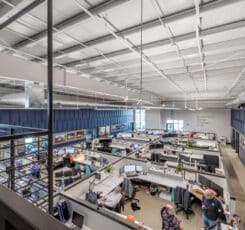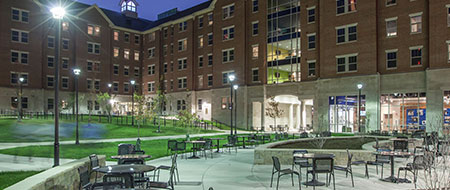When creating a building with net zero as a goal, buy-in from its occupants is crucial. That message has come through loud and clear at Richardsville Elementary, where energy usage has remained steady for five years and being a member of the student-led energy team is a prestigious, sought-after role.
“Our energy team in that school is made up of fifth- and sixth-graders and they lead energy tours,” said Warren County Schools Energy Manager Jay Wilson. “They teach adults about energy efficiencies and the technologies that are in that building. They are taking the lead on educating our community and our faculty and staff. Other schools come to Richardsville for field trips and these students actually lead other students and teach them about the building and the energy strategies that are in place.”
Some of the visitors have come from as far away as France and India.
Teachers also play a big role in making the building energy efficient.
“We looked at strategies such as going to laptops versus desktop computers,” Wilson said. “We got a variance from the state as far as being able to eliminate a computer lab and went to laptops on a cart. That was a little learning curve for our staff, but what we did was, we took out that square footage in our building that we would have had to air condition and we replaced it with three laptop carts, so now you have three mobile computer labs versus one stationary. The teachers adapted to that and found they really liked it.”
Each wing of the school is dedicated to different environmental issues, such as clean waterways, recycling, geothermal and solar energy, marked by educational murals. And the building is not only healthier for the environment, but also for student and staff health.
“When you look at making sure that our students are in a healthy environment, each room measures the air quality in the building – and again that is part of the technology in the building,” said Principal Jan Casada. “I know in the previous school, which was very old, some of my staff said they had many more students that had asthma attacks. We rarely have a situation like that (now) and I think that speaks of the building itself.”
And thanks to the energy-saving design of the kitchen, which eliminated energy-hogging appliances like fryers, meals are healthier.
Casada also believes the building will impact students’ career choices.
“In thinking about careers for their futures, I can’t help but think there are aspects of our building that are going to lead them into certain careers,” she said. “I realize that we are a rural area and already we have several farmers in the area who utilize solar panels to power their grain bins and other operations. So whether or not they stay on the farm or seek jobs elsewhere, I think these technologies are things they’re going to utilize.”
The price of ice cream
Before you can figure to how to save energy, it’s important to know what is consuming it. The anecdote about Richardsville Elementary’s ice cream freezer at the beginning of the story on the facing page is more than just an illustration of the importance of how a building is operated, said project architect Kenny Stanfield.
If that ice cream freezer had been allowed to run continuously, it would have made a sizeable dent in the savings generated by the solar panels, he said, requiring $32,000 worth of solar panels to operate.
“That just puts in perspective why energy consumption and the necessity to drive it down is so important, when you are talking about a solar array on the other side to produce as much energy as you are consuming,” he said. “That’s why it’s so critical that every kilo Btu that you can save is worth doing.”
In other words, solar panels are great, but energy saving starts with the building design.
“A building consumes energy in many different ways,” Stanfield said. “Understanding those systems and which ones of them are your targets is important. For example, when we designed Richardsville, we found out from a previous school that the commercial kitchen was consuming almost a quarter of the building’s energy, and we knew that we had to do something drastic in the kitchen or otherwise we would never get to the goals we were looking for.”
He said that caused them to look at how the cafeteria workers were cooking the food.
“If we didn’t have that data that showed us we had to do something in the kitchen, we would have never known where to target that,” he said. “And it’s the same today. It’s important, even in a highly efficient building like Richardsville, to know what’s our next target, where do we whittle away at the energy?”



